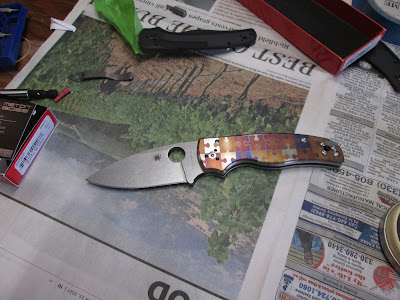I like anodized titanium.
Titanium anodizing is an
electrolytic finishing process that creates varying thicknesses of a titanium oxide
layer on the metal surface. The titanium
item forms the anode (positive electrode) of an electrolytic cell, hence the
name “anodize.”
 |
| Spyderco's Shaman in anodized titanium |
Anodizing titanium has been around for almost a century. It was first used in 1923 to protect British seaplane parts from salt-water corrosion. Aerospace companies continue to use anodizing processes today to protect metals from the effects of aging, wear and corrosion.
There are three types of
anodizing. The first is a high-temperature
process. I used to etch titanium wire
with molten sodium nitride into amazingly sharp points. I would find little splotches of concentric color
on portions of the metal.
The second is called type 2. Type 2 is used chiefly to protect the metal
surface against the effects of wear. When
untreated titanium parts rub against each other, they produce titanium dust. Titanium dust is not a major health problem,
unless it builds up in joints utilizing orthopedic implants. Type 2 anodizing provides a wear-resistant
surface and helps prevent seizing or friction between sliding titanium
surfaces. AMS 2488E has the engineering
specs if you’re interested.
 |
| Shaman tear down - remove the clip |
Type 3 is the color. You’ll find colorful titanium used in the orthopedic field to help surgeons ensure the correct plate, screws, and what-nots are used. You’ll also find colorful titanium in jewelry.
The color is not produced by
dyes, but by manipulating the oxide layer to create an “illusion of color.” This is similar to the rainbow colors an oil
film forms on water. These layers are
very thin. The entire range of colors is
produced over a 30 to 55-nanometer range, very small stuff indeed!
The process isn’t complicated. The titanium part is immersed in a trisodium
phosphate (TSP) solution and a direct electrical current is applied. Most people use a specialized rectifier to
convert AC to DC and control voltage and amperage. Since it is just a thin, durable coating, color
mistakes can be stripped off with the right detergent, and you can try again.
 |
| Guts! |
The prep for industrial products can be a bit daunting.
Sean Krizan at Meton Boss (https://www.metonboss.com/) produced
anodized titanium scales for Spyderco’s Shaman.
The scales were engraved to resemble an interlocking jigsaw puzzle, with
the ‘pieces’ having different anodizing colors.
It was amazing, and I threw money
at him to make it mine. I didn’t have a
Shaman yet, but that shouldn’t be a problem, right?
It was the beginning of the Covid
age of supply shortages. I placed an
order for one from a knife seller. A
year later, I was still waiting. I
called Spyderco and was told the knife was still in production, but supply
shortages ..yadda…yadda…yadda.
What if they were discontinued?
What if I couldn’t find one?
Was I FUBARed?
 |
| Yes, Igor threw the switch - Is it alive? |
I purchased a fully serrated Shaman,
despite wanting a plain blade, just in case. Now that I had one, even if it was a plan B
option, I could relax. Eventually, I
finally found a plain edge at a knife show and bought it.
I had to dissemble the knife to
remove the original scales, voiding Spyderco’s warranty. I took lots of snapshots of the process, just
in case I ended up with an extra washer or screw when I was finished re-assembling
my Shaman. I worked on a pile of newspaper
for the cushion and used painter’s tape for surface protection. I also discovered I was all thumbs. Still, it all worked out.
 |
| I get nothing for showing his card. Still. there are some amazing products there! |
 |
| It's alive!! |
The Shaman is spectacular!
No comments:
Post a Comment